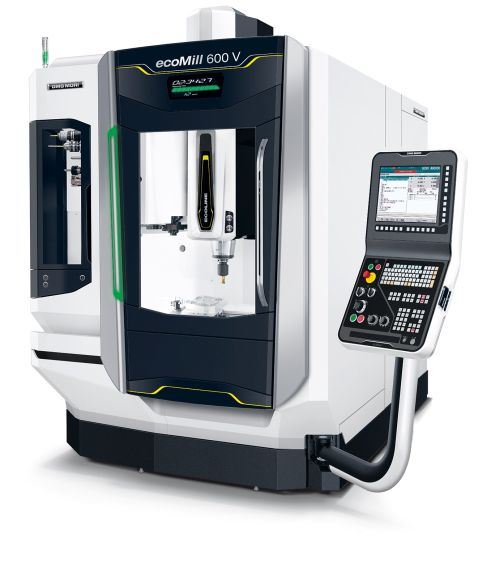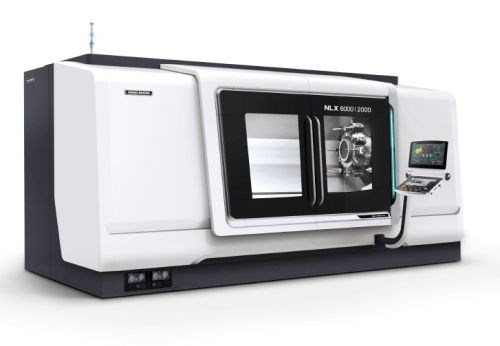DMG MORI to Showcase Big-Bore Turning, New VMC Tech at EMO
The company will feature an entirely new VMC design and a turning center designed specifically for energy industry, hydraulic and mechanical engineering applications.
Share
Read Next
Among the highlights of DMG MORI’s display at the EMO show in Hannover, Germany October 5-10 is an entirely new VMC design and a line of turning centers featuring big-bore spindles and robust construction.
The new VMC series is the ecoMill V. Three available models, the 600 V, the 800 V and the 1100 V accommodate workpieces as heavy as 1,322.7 lbs., 1,763.7 lbs. and 2,204.6 lbs., respectively. X-axis travels on the three models are 2.3.6” (600 mm), 31.5” (800 mm) and 43.3” (1,100 mm). Y-axis travel of 22” (560 mm) is said to provide a large work area relative to the machien’s compact footprint.
Rapid traverse speed of the X and Y axes is 36 m/min, and the rapid traverse speed in the Z direction is 30 m/min. Positioning accuracy is 0.0002” without direct scales, due to direct coupling in X / Y and no belt drive for no backlash. Tool changes are as fast as 1.3 seconds. According to the company, an FEM-optimized cast iron C-frame design provides stable machining, while a 30-pocket tool magazine adds flexibility. The optional chip conveyor can be positioned at the rear or left side of the machine.
The company also prioritized ergonomics in machine design. Anodized aluminum finishes are said to be more robust and scratch-resistant and powder-coated metal claddings, which helps to make the machine cladding more durable and increases value stability. The safety windows are can be easily replaced from the outside if they become damaged. An optional window provides access to the tool magazine during production. The new design also improves accessibility to the table for ergonomic loading and unloading (table height is 33.5”, and the distance to the table is 12.3”), as well as a scratch- and wear- resistant surface for a higher reliability.
Another highlight is the company’s Slimline panel CNC interface (15”/MAAPS IV on Fanuc), which is said to be ergonomic and easy to operate. Users can also control workpiece shapes and toolpaths via 3D machining simulation on the 15”, high-resolution TFT monitor. Starting in March 2016, the machines will also be available with a 19” platform on a Siemens 400-V control and expanded memory capacity) from 5 MB to 4 GB).
DMG MORI will also highlight its NLX 6000/2000 universal lathe. The largest model in the NLX series, this machine is designed for machining large workpieces as large as 78.7” long and 36.2” in diameter, specifically for energy/oil industry, hydraulic and mechanical engineering applications. Its construction is based on a 45-degree slanted bed with flat guides as wide as 7.1” in all axes for damping and dynamic rigidity. Ball screws with a diameter of 1.9” and a headstock with integrated motor spindle and a built-in tailstock ensure additional stability during machining, the company says. X-, Y- and Z-axis travels are 19” (485 mm) × 7.8” ± 3.9”(200 mm ± 100 mm) × 84.6” (2,150 mm), and maximum chuck size is 23.6” (600 mm).
Like the work area, available spindle bores are designed for large parts. Three spindles are available: Type B, a 185-mm-diameter option with 1,600 rpm, 60 hp, 5,178.4 ft. lbs.; Type C, a 285-mm-diameter option with 1,000 rpm, 60 hp, and 8,895.7 ft lbs; and Type D, a 375-mm option with 500 rpm, 60 hp and 8,911.2 ft. lbs. An optional BMT turrent features an integral drive motor with a maximum speed of 4,000 rpm and 86.3 ft. lbs. of torque and space for 12 powered tools.
The machine also features a scratch-resistant, powder-coated housing, ergonomic door handles and easy viewing of the work area. Another feature designed with comfort in mind is the 21.5” touchscreen control panel featuring the company’s CELOS interface and MAPPS V. The six-window display provides simultaneous access to a variety of information. This includes a tool management system (TMS) for displaying tool information. Also on board is a a visual programming system (VPS) that combines the input the G/M code and predefined cycles. It also simulates the machining operation and provides a 3D interference check for automatic collision control, which accounts for the spindles, workpieces, tools and clamping devices. Automatic inclusion of already machined areas to enable shorter travel paths also reduces machining times, the company says.
Read Next
How to Use Continuing Education to Remain Competitive in Moldmaking
Continued training helps moldmakers make tooling decisions and properly use the latest cutting tool to efficiently machine high-quality molds.
Read MoreHow to Use Strategic Planning Tools, Data to Manage the Human Side of Business
Q&A with Marion Wells, MMT EAB member and founder of Human Asset Management.
Read MoreAre You a Moldmaker Considering 3D Printing? Consider the 3D Printing Workshop at NPE2024
Presentations will cover 3D printing for mold tooling, material innovation, product development, bridge production and full-scale, high-volume additive manufacturing.
Read More


















